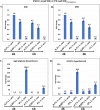Transcriptional Responses of Pseudomonas aeruginosa to Inhibition of Lipoprotein Transport by a Small Molecule Inhibitor
- PMID: 32989085
- PMCID: PMC7685553
- DOI: 10.1128/JB.00452-20
Transcriptional Responses of Pseudomonas aeruginosa to Inhibition of Lipoprotein Transport by a Small Molecule Inhibitor
Abstract
Lipoprotein transport from the inner to the outer membrane, carried out by the Lol machinery, is essential for the biogenesis of the Gram-negative cell envelope and, consequently, for bacterial viability. Recently, small molecule inhibitors of the Lol system in Escherichia coli have been identified and shown to inhibit the growth of this organism by interfering with the function of the LolCDE complex. Analysis of the transcriptome of E. coli treated with one such molecule (compound 2) revealed that a number of envelope stress response pathways were induced in response to LolCDE inhibition. However, Pseudomonas aeruginosa is refractory to inhibition by the same small molecule, but we could demonstrate that E. colilolCDE could be substituted for the P. aeruginosa orthologues, where it functions in the correct transport of Pseudomonas lipoproteins, and the cells are inhibited by the more potent compound 2A. In the present study, we took advantage of the functionality of E. coli LolCDE in P. aeruginosa and determined the P. aeruginosa transcriptional response to LolCDE inhibition by compound 2A. We identified key genes that responded to LolCDE inhibition and also demonstrated that the same genes appeared to be affected by genetic depletion of the native P. aeruginosa LolCDE proteins. Several of the major changes were in an upregulated cluster of genes that encode determinants of alginate biosynthesis and transport, and the levels of alginate were found to be increased either by treatment with the small molecule inhibitor or upon depletion of native LolCDE. Finally, we tested several antibiotics with differing mechanisms of action to identify potential specific reporter genes for the further development of compounds that would inhibit the native P. aeruginosa Lol system.IMPORTANCE A key set of lipoprotein transport components, LolCDE, were inhibited by both a small molecule as well as genetic downregulation of their expression. The data show a unique signature in the Pseudomonas aeruginosa transcriptome in response to perturbation of outer membrane biogenesis. In addition, we demonstrate a transcriptional response in key genes with marked specificity compared to several antibiotic classes with different mechanisms of action. As a result of this work, we identified genes that could be of potential use as biomarkers in a cell-based screen for novel antibiotic inhibitors of lipoprotein transport in P. aeruginosa.
Keywords: LolCDE; Pseudomonas; lipoprotein transport; molecular inhibitor; transcriptome.
Copyright © 2020 Lorenz et al.
Figures












Similar articles
-
Correct Sorting of Lipoproteins into the Inner and Outer Membranes of Pseudomonas aeruginosa by the Escherichia coli LolCDE Transport System.mBio. 2019 Apr 16;10(2):e00194-19. doi: 10.1128/mBio.00194-19. mBio. 2019. PMID: 30992347 Free PMC article.
-
Transcriptional Responses of Escherichia coli to a Small-Molecule Inhibitor of LolCDE, an Essential Component of the Lipoprotein Transport Pathway.J Bacteriol. 2016 Nov 4;198(23):3162-3175. doi: 10.1128/JB.00502-16. Print 2016 Dec 1. J Bacteriol. 2016. PMID: 27645386 Free PMC article.
-
Characterization of the Pseudomonas aeruginosa Lol system as a lipoprotein sorting mechanism.J Biol Chem. 2007 May 4;282(18):13379-84. doi: 10.1074/jbc.M611840200. Epub 2007 Mar 9. J Biol Chem. 2007. PMID: 17350955
-
Genome-wide analysis and literature-based survey of lipoproteins in Pseudomonas aeruginosa.Microbiology (Reading). 2010 Sep;156(Pt 9):2597-2607. doi: 10.1099/mic.0.040659-0. Epub 2010 Jul 8. Microbiology (Reading). 2010. PMID: 20616104 Review.
-
Sorting of lipoproteins to the outer membrane in E. coli.Biochim Biophys Acta. 2004 Nov 11;1694(1-3):IN1-9. Biochim Biophys Acta. 2004. PMID: 15672528 Review.
Cited by
-
Biofilm Disruption from within: Light-Activated Molecular Drill-Functionalized Polymersomes Bridge the Gap between Membrane Damage and Quorum Sensing-Mediated Cell Death.ACS Biomater Sci Eng. 2024 Sep 9;10(9):5881-5891. doi: 10.1021/acsbiomaterials.4c01177. Epub 2024 Aug 23. ACS Biomater Sci Eng. 2024. PMID: 39176452 Free PMC article.
-
Functional genomics study of Pseudomonas putida to determine traits associated with avoidance of a myxobacterial predator.Sci Rep. 2021 Aug 12;11(1):16445. doi: 10.1038/s41598-021-96046-8. Sci Rep. 2021. PMID: 34385565 Free PMC article.
References
Publication types
MeSH terms
Substances
Grants and funding
LinkOut - more resources
Full Text Sources
Medical
Research Materials

